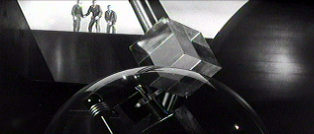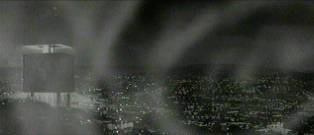| Reviews & Columns |
|
Reviews DVD TV on DVD Blu-ray 4K UHD International DVDs In Theaters Reviews by Studio Video Games Features Collector Series DVDs Easter Egg Database Interviews DVD Talk Radio Feature Articles Columns Anime Talk DVD Savant Horror DVDs The M.O.D. Squad Art House HD Talk Silent DVD
|
DVD Talk Forum |
|
|
| Resources |
|
DVD Price Search Customer Service #'s RCE Info Links |
|
Columns
|
|
|
Kronos
A special treat from Image last week was the DVD debut of one of the most over-achieving lowbudget Science Fiction films of the 50s, Kurt Neumann's Kronos. Wade Williams has added a subtitle, "Ravager of Planets" for some brainless purpose, but he can be forgiven for two happy reasons - the movie itself is intact and 'unimproved' (see Invaders from Mars and Rocketship X-M), and the quality is top-notch. Savant finally saw this film letterboxed in CinemaScope on AMC television a few years back, and it looks even better on this DVD release.
All the 1957 reviews of Kronos were positive - the contemporary reviewers were impressed by the special effects and thought the film the equal of many a much-higher budgeted effort. By 1957 the A-Picture high-class Science Fiction film was a fading fad. Kronos' immediate competition were groaners like The Unknown Terror. Interestingly enough, one of the last classics of the Sci Fi first wave was made from a script by the same men who would re-team for Kronos.

Irving Block and Jack Rabin ran an all-purpose optical service in the 50s made possible by the slew of independent productions without access to studio optical departments. Their work is everywhere, from awful $50 visuals in things like Monster from Green Hell to brilliant work in Night of the Hunter. Very creative and ambitious, the duo contributed to several lowbudget films before making a big sale to Dory Schary at MGM - their 'Fatal Planet' eventually became Forbidden Planet, one of the few Science Fiction films whose center was a real, abstract Science Fiction concept.
Forbidden Planet's tale of an alien society whose self-perpetuating machines were a menace millenia after their own extinction was a 'Big Idea' - some of the strongest scenes in the film were totally non-narrative contemplations of the vast and unknowably complex 'instrumentalities' of the alien Krell. When Dr. Morbius points to miles of airshafts and the opening and closing of countless relays, Block and Rabin's visionary super-machine resembles a modern computer. In its tying together of the entire planet of Altair-4, it also evokes a vision of the Internet.
Kronos is a Big Idea movie as well. Its star is a titanic cubic tinkertoy, a robot from outer space sans face or personality. Its menace is completely impersonal, and its mission is to drain every erg and kilowatt of energy from the Earth, for the benefit of its unseen controllers.
A truckdriver is possessed by a jolt of electricity from a fallen meteorite, and breaks into a desert research institute called LabCentral. The electrical lifeform transfers itself to the head of the lab, Dr. Hubbell Eliot (John Emery), who from then on functions as a double-agent for unseen aliens, directing the landing of a strange machine, Kronos, from space, and then helping guide it on an uniquely weird mission to 'sap the Earth of every drop of energy.'
LabCentral s top scientists (its only staff, judging on what we see) go to Mexico to monitor the fallen object, and discover that Kronos is actually a robotlike machine, two upright cubes topped by a dome and standing on piston-piledriver legs. They briefly inspect the robot's interior by landing a helicopter on its top. Kronos' futuristic contents betray nothing of its intended function until, guided from afar by Dr. Eliot, it starts seeking out power plants. The robot robs the energy they hoard in electronic plasma storms of electric bolts and ray blasts. Waves of energy flow and ebb across the skies as it literally vacuums up every iota of power to be found.
A B47 is dispatched to bomb Kronos just as our heroes determine that nuking the monster would just feed it more energy. But Kronos employs a pre-Star Trek tractor beam to pull the bomber to its target - and emerges from the radioactive cloud exponentially larger, seemingly a mile or more tall. A last-ditch solution is cobbled together only as Kronos, now an unstoppable colossus, nears panic-stricken Los Angeles.

The Kronos robot is a wonderfully compact Science Fiction concept. Described at one point as an 'Accumulator', Kronos is infinitely interpretable as a comment on gluttonous consumerism, but more easily represents exactly what it is, an impersonal mechanism by which a higher technological culture feeds off a lower one. Like indians watching their rainforest snatched away acre by acre, humans can only watch as Kronos steals Earth's resources like an unopposable force of nature. Science is nifty, but its tools are suspicious. LabCentral's computer SUSIE isn't traitorous, like the topsecret computer into which the aliens hack in GOG, but it still can't be trusted any more than can Kronos itself.
Kronos is a conservative fantasy, and Kronos itself a powerful symbol. The design of the titan is brilliant. Its simple collection of shapes has no style and no personality, it is un-analyzable. Surely Stanley Kubrick learned his 2001 lesson here; like the monolith, Kronos doesn't date. In this movie, kids, Earth is invaded by Abstract Art from Outer Space. At once arresting, every view of Kronos remains fascinating. 1 It stands on the horizon, its head in the clouds, an unexplainable manifestation of an unknowable Future. (see image below)
Once the action gets going, Kronos is an unbroken series of unique, weird special effects sequences, accomplished through simple opticals and superior design. Even cel animation is used for a few shots, which have always been criticized by scoffers who didn't want animated cartoons in their Sci Fi films. Today, that's almost all there is to special effects.
The giant glowing shape glimpsed on the Pacific horizon is yet another architectural dome menace from 1957 (the others are The Mysterians and Quatermass 2). The camera pans across very effective matte paintings that show Kronos plowing giant grooves into Mexican valleys with its giant piston feet. Kronos' physical mobility is almost as unconvincing as the broccoli monsters of Day of the Triffids. Perhaps the pistons function to level a path, and Kronos really hovers on some kind of levitating ray, as it appears to do in animated longshots. The Navarez Electro sequence is a dramatically-lit, convincing riot of rays and smoke superimposed over clearly identifiable Lionel-gauge train model switchtowers and signal arches. They reminds former miniatures flunky Savant of the dozens of plastic models he cannibalized for the 'Kluge' detail on the Mothership of CE3K. In the final assault on LA, lights representing neighborhood power grids turning off are simple dots superimposed on a photo of the Los Feliz hills. Block and Rabin give the manifestations of Kronos a disturbing organic look, in the flow of crackling metal as the alien lifeform exits the dead body of Dr. Eliot, and in the eerie waves that ebb and flow from Kronos as it vacuums up energy. Some of these look like cleverly superimposed shots of foamy surf taken at a seashore, here transmogrified into 'power waves'. In an interview, Block said one of the angles on the giant Kronos standing alone in the desert was achieved by putting the model on a white sheet and airbrushing hills and rocks onto it.
Kronos' possession theme places the scientific menace in a supernatural context. John Emery becomes a hypnotically controlled pawn like the luckless humans in Invaders from Mars, Quatermass 2 and It Conquered the World. His eyes are lit with Bela Lugosi-style spotlights, and bubbling liquids are superimposed over his face, for added visual effect. Psychic communication with aliens figures heavily in films from The Trollenberg Terror to E.T., the Extraterrestrial. Emery's psychic link gives Kronos a similar human connection; without it the movie might have become the kind of programmer where the effects never really have anything to do with the live-action ... Savant's thinking of The Giant Claw here.
The effectiveness of the big scenes in Kronos is greatly augmented by the film's creative sound mix. Whistles, klaxons, crackling electrical noises accompany the usual explosions and raygun noises and fuse with the baleful, pounding music score into a Sci Fi Wall Of Sound. The thunderous score, one of Sawtell and Shefter's most memorable, creates an atmosphere of gigantic forces run amok. The main theme, by the way, was reworked for both the 1958 It!, the Terror from Beyond Space, and 1959's Gigantis, The Fire Monster.
The level of the dramatics in Kronos is strictly '50s-glib', making it on the surface more like The Giant Claw than Forbidden Planet. Hero Dr. Leslie Gaskell (Jeff Morrow) is one of those research scientists who also flies up to date aircraft, in this case a helicopter. He has a sidekick, Dr. Arnold Culver, (George O'Hanlon) a comic egghead who doesn't even claim to understand the intricacies of his own SUSIE, a computer given a female nickname and credited with a femme personality when its functions become capricious. (Caprice - what a name for a car! Maybe it will run, maybe it won't). Unlike This Island Earth, both scientists here are emasculated by the workaholic demands of their jobs at LabCentral ( it must be down the block from 'Pacific Tech'). Gaskell has an ever-patient girlfriend lab assistant, Vera (Barbara Lawrence), who can't get twenty seconds of his attention, let alone a night out at a movie. Since LabCentral is shown to be in a remote corner of the California desert, that must be quite a drive to the drive-in. Kronos has one of the 50s best howler dialog lines, delivered by Morrow during a soggy clinch on a Mexican beach:
"Do you think you'll be able to respect a husband who probably pulled the biggest scientific boner of all time?"
Other details show the kind of uncoordination that crops up in movies made too fast or without adequate supervision. The 'Metaluna factor', as Savant calls it, is when your characters describe subtle things like slight indentations on the foreheads of people who may be aliens ... and then when the aliens actually show up, they have bulbous domes three inches taller than anything human. Somehow the script people and the production designers weren't talking to each other. The UFO in the beginning of Kronos is viewed on a mysterious telescope scanner that plays its progress like a television, with automatic cuts. This doesn't exactly count as a flaw, because surveillance cameras that follow people and even edit their views still show up in movies. But Kronos has quite a few other head-scratchers. While the robot is still a curiosity standing passively on a beach, newscasters (played by real LA newscasters, a nice touch) hold up sketches for the TV cameras. The first sketch makes Kronos, look like an espresso machine, a nice touch if it's meant to be unreliable reportage. A bit later, a rendering by an apparently clairvoyant artist shows a (very ad art-looking) full-sized colossus on a rampage, the monster that Kronos has not yet become. When the possessed Dr. Eliot tells his associates how to defeat Kronos, they record his words. We see the tape recorder start rolling a sentence or two after the doctor's starts talking, but when the tape is replayed, his whole speech is recorded. The psychiatrist (Morris Ankrum) is electrocuted at an indoor transformer power station, presumably the kind that powers a large buidling. But this hospital's transformer substation is located in the office of the head of Psychiatric Treatment, a few steps from his consulting desk. Is the good doctor conducting shock treatment trials on elephants in his spare time? On Kronos' trek through Mexico, there are numerous cutaways to stock footage obviously shot in Hawaii. Panicked citizens in Hawaiian shirts run through the hills of Oahu. A very nice effects shot shows Kronos threatening a sugar-cane field as hundreds of Hawaiians flee. If Savant is not mistaken, the depression in the hills behind Kronos in this shot is Kolekole Pass, the infamous route taken by the torpedo planes that bombed Pearl Harbor! Block and Rabin must have had cheap access to some CinemaScope stock footage from an unknown Fox film set in Hawaii. Another clue that Kronos was an 'on the lot' Fox film is the use of the pop song 'Something's Gotta Give' as soundtrack source music. LabCentral also sports parts of setpieces constructed for the Fox films Desk Set, and The Day the Earth Stood Still.
Two of Kronos' sublime moments revolve around the atom bomb. When the alien tractor beam draws the B47 inexorably into a H-blast, the angles and cutting enforce a sense of impending doom as we focus on the imminent impact. The effect prefigures the Yahoo bomb scene in Dr. Strangelove, and works almost as well.
The conclusion of Kronos is another thing altogether. Here the Metaluna Factor has its purest expression, or maybe it's an irresistable joke by Block, Rabin and director Kurt Neumann. Our scientist heroes look on in glee as their dimestore physics succeed in making Kronos melt and crumble like the Krell door in Forbidden Planet. Then suddenly, Kronos erupts in a nuclear explosion, a giant, stockshot blasteroonie. This is happening right in the middle of Los Angeles, not out in the desert somewhere - it looks to Savant like Kronos is standing either in Toluca Lake, or behind Dodger Stadium. And our heroes must be watching from someplace nearby, perhaps the tower at the Burbank Airport, only a few miles away. (the movie implies it's an Air Force Fighter Wing, of which there were none in LA ...) A few seconds after the devastating blast, Gaskell and Vera are cheerfully told by sidekick Arnie that they still might make it to a late show! In what? Radiation suits? This had to be a joke.

Image's DVD of Kronos is a very clean non-16:9 transfer from very good elements. Scratches and damage are minimal. Most of the schmutz is on the copious stock footage on view, and was probably there when the film was new. The mono track is exceptionally clear and the aural detail in the very-busy destruction scenes is striking - this was the first time Savant could hear those transformers blowing as Kronos blacked out grid after grid of Los Angeles power. An effective trailer is the only extra. The package artwork is pretty dismal, with an especially grotesque rendering of Jeff Morrow. But it is loud and colorful. How come cheap 35-cent 50s pocketbooks could have stunning oil-painting covers, whereas our DVDs are largely garish paste-up photoshop rejects? This is for you, Mr. Wade ...
Far too many '50s invasion films are to laugh at, but Kronos delivers a fascinating concept and a stunning production that transcends its own silly dramatics. The tinkertoy from outer space is really a cosmic Golem that, due to superior design and special effects, has remained compelling. Savant rates Kronos an A-, right up there under the top classics of the Science Fiction genre. With its impressive letterbox presentation, Image's DVD is a highly desirable title.
On a scale of Excellent, Good, Fair, and Poor, Kronos rates:
Movie: Very Good
Video: Very Good
Sound:Excellent
Supplements: trailer
Packaging: Snapper case
Reviewed: April 27, 2000
Footnotes:
1. In the 70s, NBC in Burbank had a local affiliate logo sculpture outside their building that looked a lot like Kronos, at least the two-cubes part. Anyone coming to see a Johnny Carson taping would wait in line by it. At the time, David Allen's animation studio was just a few doors away; he once entertained the idea of sneaking over there at night and crowning the sculpture with an antennae'd dome. Return
| |
|
| Popular Reviews |
| Sponsored Links |
|
|
| Sponsored Links |
|
|
| Release List | Reviews | Shop | Newsletter | Forum | DVD Giveaways | Blu-Ray | Advertise |
|
Copyright 2024 DVDTalk.com All Rights Reserved. Legal Info, Privacy Policy, Terms of Use,
Manage Preferences,
Your Privacy Choices | |||||||













